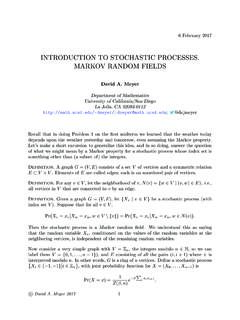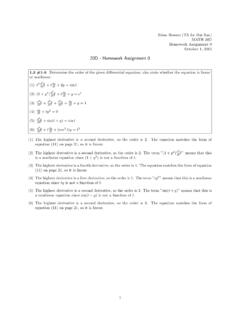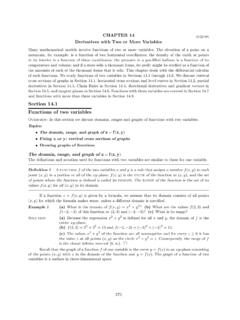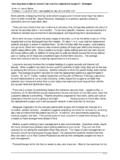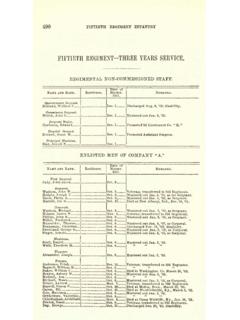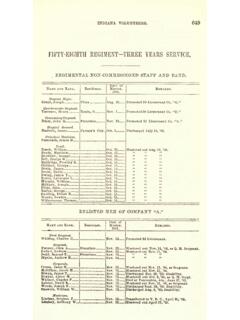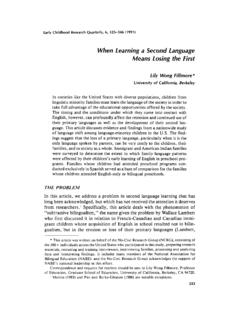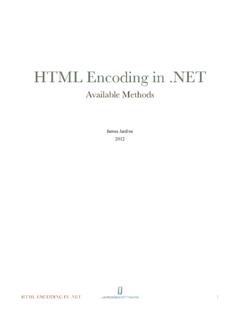Transcription of Introduction - UCSD Mathematics
1 VIRTUAL INTERSECTIONS ON THE quot SCHEME ANDVAFA-INTRILIGATOR FORMULASALINA MARIAN AND DRAGOS construct a virtual fundamental class on the quot scheme parametriz-ing quotients of a trivial bundle on a smooth projective curve. We use the virtuallocalization formula to calculate virtual intersection numbers on quot . As a conse-quence, we reprove the Vafa-Intriligator formula; our answer is valid even when theQuot scheme is badly behaved. More intersections of Vafa-Intriligator type are com-puted by the same method. Finally, we present an application to the non-vanishingof the Pontrjagin ring of the moduli space of study the intersection theory of the quot scheme Quotd(ON,r,C) of degreed,rankN rcoherent sheaf quotients ofONon a smooth complex projective curveCofgenusgvia equivariant (ON,r,C) provides a compactification of the scheme Mord(C,G(r,N)) of degreedmorphisms fromCto the GrassmannianG(r,N),and has been analyzed a lot from thispoint of view.
2 Indeed, Mord(C,G(r,N)) sits inside Quotd(ON,r,C) as the subscheme oflocally freequotients ofON. For large degreed, certain counts of maps fromCtoG(r,N)can in fact be realized as intersection numbers on Quotd(ON,r,C), and can be carriedout in this setting [BDW], [B]. Part of the intersection theory on Quotd(ON,r,C) hasthus been well studied. In this paper, we note that all of the intersection theory onQuotd(ON,r,C) can be explicitly computed by exploiting the naturalC?-action of thesituation and the ubiquitous virtual localization theorem [GP]. In particular we recoverthe intersection numbers which have already been known, and which are given by theelegant formula of Vafa and now detail the discussion. quot schemes have been shown by Grothendieck [Gro],in all generality, to be fine moduli spaces for the problem of parametrizing quotientsof a fixed sheaf, and as such to carry universal structures.
3 For the case under study,quotients ofONon a curveC, let0 E ON F 0be the universal family on Quotd(ON,r,C) note for further use that the Zariskitangent space to Quotd(ON,r,C) at a closed point [0 E ON F 0] is12 ALINA MARIAN AND DRAGOS OPREAExt0(E,F), while the obstructions lie in Ext1(E,F). Hence the expected dimension ofQuotd(ON,r,C) ise= (E F) =Nd r(N r) usual, we write g=g let{1, k,1 k 2g, }be a symplectic basis for the cohomology ofCand letci(E ) =ai 1 +2g j=1bji j+fi be the K unneth decomposition of the Chern classes of the dual universal bundleE .Note thatai H2i(Quotd(ON,r,C)), bji H2i 1(Quotd(ON,r,C)),fi H2i 2(Quotd(ON,r,C)).Moreover, letpbe a point onCand letEpdenote the restriction ofEto Quotd(ON,r,C) {p}. We write : Quotd(ON,r,C) C Quotd(ON,r,C)for the projection on the first factor. It is clear thatai=ci(E p) andfi= ?ci(E ).Since the quot scheme may have several possibly oversized irreducible components,making sense of intersection numbers can be subtle.
4 The machinery of virtual modulicycles of [LT], [BF] was developed precisely to deal with such issues. Our first result isthe existence of a virtual fundamental class on Quotd(ON,r,C). It will sometimes beconvenient to writeQdfor Quotd(ON,r,C), when no confusion is scheme Quotd(ON,r,C)admits a perfect obstruction theory and avirtual fundamental class[Qd]virof the expected should come as no surprise, and has in fact been known to some experts. Thereferee pointed out that an independent proof of this result is contained in the unpub-lished manuscript [CFK2]. There, the construction of the virtual fundamental classrelies on the existence, demonstrated in [CFK1], of a dg-manifold, the derived Quotscheme, whose degree 0 truncation is the usual quot scheme. Moreover, constructionsof virtual fundamental classes of similar flavor arise in higher dimensions in the contextof Seiberg-Witten theory for the Hilbert scheme of divisors on a surface [DKO] andDonaldson-Thomas theory for moduli spaces of sheaves on threefolds [T].
5 We remarkthat our arguments can be extended to more general situations; in particular it is notnecessary to consider quotients of the trivial bundle. However, this case suffices for theapplications we have in INTERSECTIONS ON THE quot -SCHEME3 Next, fixingp C, there is a natural embeddingip: Quotd(ON,r,C) Quotd+r(ON,r,C)obtained by twisting subbundles byO( p). This exhibits Quotd(ON,r,C) as the zerolocus of a section of(E Np) . The virtual classes we construct are compatible withrespect to this following equality holds true:i?[Quotd(ON,r,C)]vir=ctop(E p)N [Quotd+r(ON,r,C)] (N) acts naturally on Quotd(ON,r,C) by sending quotients onCto theircomposition with automorphisms ofON. Furthermore, the dual universal bundleE isGL(N)-equivariant. We will look at the restriction of the action to a diagonalC?insideGL(N),and will apply the virtual localization formula of [GP], obtaining thatProposition monomials in thea,bandfclasses can be explicitly evaluated onthe virtual fundamental class[Qd] large degreedrelative tor,Nandg, Quotd(ON,r,C) is generically reduced,irreducible of the expected dimension [BDW].
6 The virtual fundamental class agreeswith the usual fundamental class, hence we are computing honest intersection this large-degree regime, intersections ofa-classeswere studied extensively in [B].It is shown there that the evaluation of a top-degree monomial in thea-classes on thefundamental cycle has enumerative meaning: it is the number of degreedmaps fromCto the GrassmannianG(r,N) which send fixed pointspionCto special Schubertsubvarieties ofG(r,N).The number of such maps is computed by the Vafa-Intriligatorformula [I]. Further in [B], the author evaluates, up to a calculation in genus 0, the topintersection ofa-classes on Quotd(ON,r,C) by degenerating to lower genus, hence heessentially proves the Vafa-Intriligator formula. In addition, he definesa-intersectionnumbers in low degree. Our Theorem 2 shows that Bertram s definition gives rise tovirtual intersection numbers.
7 Thus our approach clarifies issues related to the badbehavior of the moduli should also be mentioned that a complete proof of the Vafa-Intriligator formula iscontained in [ST]; it exploits the standard presentation of the small quantum cohomol-ogy ring ofG(r,N) and uses too a degeneration of the curve to genus localization, we explicitly compute thea-intersection numbers, recovering theformula of Vafa and Intriligator. The formulation below follows Bertram s paper [B].In the proof, we explain how each term in the Vafa-Intriligator formula arises as acontribution from various fixed loci. We will investigate a similar formula for HyperQuotschemes in future MARIAN AND DRAGOS OPREAT heorem (X1,..,Xr)be a polynomial of weighted degreee, where the variableXihas degreei. DefineJ(x1,..,xr) =Nr x 11 .. x 1r 1 i<j r(xi xj) ,P(a1,..,ar) [Qd]vir=u 1,.., rR( 1,.., r)Jg 1( 1.)
8 , r),the sum being taken over all(Nr)tuples( 1,.., r)of distinctNthroots of unity. Here,u= ( 1)(g 1)(r2)+d(r 1),andRis the symmetric polynomial obtained by expressingP(a1,..,ar)in terms of theChern roots ofE , we will strengthen the theorem above by considering intersections ofaandcertainbclasses. While more general formulas can be written down, we will only notehere thatProposition alls dand1 j1< .. < js g,(bj11bj1+g1 .. bjs1bjs+g1)P(a) [Qd]vir=uNs 1,.., r( 1+..+ r)s (RJ g)( 1,.., r).The expression evaluates to0fors > observed in Proposition 1 that all intersection numbers onQdcan in principlebe computed; precise formulas are not always easy to obtain. We further derive thefollowing intersection number which is reminiscent of the expression obtained by Vafaand Intriligator as any polynomial of weighted degreee l+ 1, where2 l the symmetric polynomial obtained by expressingP(a1.
9 ,ar)in terms of theChern roots. The intersection productfl P(a1,..,ar) [Qd]virequals the following sum over all the(Nr)tuples of distinctN-roots of unityuN 1,.., r(DlR)( 1,.., r) Jg 1( 1,.., r),whereDlis a first order linear differential operator defined by equation(58).An intersection number on Quotd(ON,r,C) involvingfclasses should morally cor-respond to a count of degreedmaps fromCtoG(r,N) whose images intersect givenspecial Schubert subvarieties ofG(r,N).Unfortunately, due to the bad nature of theVIRTUAL INTERSECTIONS ON THE quot -SCHEME5boundary of the Quotd(ON,r,C) compactification, anaandfintersection number doesnot have enumerative meaning in general; some of these issues are addressed in [M].Nonetheless, evaluating general top monomials ina,fandbclasses has importantapplications to the computation of the intersection numbers on the moduli spaceM(r,d)of rankr, degreedbundles onC, whenr,dare coprime.
10 It was shown in [M] that forlargeNandd, any top intersection product of the cohomology generators ofM(r,d)can be realized as a top intersection ofa,fandbclasses on Quotd(ON,r,C), hence iscomputable by the methods of this work. This gives an algebraic way of calculating theintersection theory ofM(r,d), and could thus provide an alternative to the pioneeringwork [JK]. An ampler exploration of the intersection theory onM(r,d) via equivariantlocalization on Quotd(ON,r,C) will be taken up in a future paper. Note that completeresults in rank 2 are obtained in [MO].The vanishing of the ring generated by the Pontrjagin classes ofM(r,d) in degreeshigher thanr(r 1)(g 1) was proved in [EK]. There, the optimality of the result isalso shown, by producing a nonzero element of degreer(r 1)(g 1). We will replicatethis optimality statement as an application of the Vafa-Intriligator formula exists a non-zero element of degreer(r 1)(g 1)in the Pontrjaginring ofM(r,d).

